Wallows makes first trip to



With the shutdown of UTSA’s Child Development Center, stu dents with children are reevalu ating their experience at UTSA.
The Center has experienced recurring short-term closures since it reopened in January 2021. In November of the same year, the Center on Main Cam pus had to shut down due to a fire in its HVAC system. Eventu ally, in April 2022, the university announced its intention to cease operations on May 31.
Senior Vice Provost for Student Affairs and Dean of Stu dents, LT Robinson, partnered with Business Affairs to propose renovations and plans for the Center. Robinson explained that a new child care model is being developed as a part of the partnership.
“I am leading a team that is exploring new options to support UTSA students who have chil dren,” Robinson said. “We are creating a new child-care model that will better meet the needs of students with children — needs that have changed as a result of the pandemic. Our group will spend about a year exploring all of the available options, espe cially the opportunity to collabo rate with community partners. I encourage you to re-visit this story in Fall 2023 when a plan is in place and there are updates to share.”
The Child Development Center is a home and commu nity for students, who have built relationships with the staff to ensure trust and safety for their children.
One of these students is Kelsey Santibanez, who ex pressed feeling comfortable in leaving her children at the Center.
“[The Child Development Center] was [a place where] we created a small village of faculty,” Santibanez said. Since the Center closed, students have also had to adjust their daily commutes. The Cen ter was located between parking lots 10 and 11 on the southwest
side of the Main Campus, mak ing it an accessible location for students who have on-campus classes or need to study. How ever, the shutdown has changed this.
UTSA recommended a list of daycares where students can enroll their children for the forthcoming semester. However, this change could have an impact on the commute and education of affected students.
“[The Center made it] a lot easier to get to class, drop the baby off and leave instead of living about an hour away, making the commute of like an hour there and an hour back. So, it just helped me out a ton,” Chelsey Detrick said.
For more than a year, students with children continue to be left without financial assistance. Out of the many benefits, UTSA provided enrolled students with financial grants to help with the cost of the center.
“Financially, it’s also been different because I got a 50% grant at the daycare on campus,” Santibanez said “They offer it if you meet a certain requirement ... I think [it] just like goes off your income and your GPA … I got a 50% grant for both of my kids. So essentially, I was paying for one child. It was like a two-for-one deal which helped [substantially].”
This lack of financial assis tance is coupled with concerns about daycare expenses.
“I was paying around like a little less than $650 a month for two kids on campus. Now, I’m paying I think $1400 [for a month], $350 [for] a week. So, yeah, it at least doubled,” San tibanez said.
Months without the Center have also affected students, their family and their education.
“I think after a year of not having child care, and not being able to make it to class, I prob ably wouldn’t be able to attend UTSA anymore,” Detrick said.
On Thursday, Oct. 13, UTSA hosted the U.S. Secretary of Education Miguel Cardona as one of its keynote speakers for Hispanic Heritage Month. Cardona was joined in the virtual webinar by President Taylor Eighmy and Teresa Niño, vice president for university relations.
Cardona, who was born in Connecticut to Puerto Rican parents, began by talking about his experience growing up in America.
“We had love, family and of course pride in my Puerto Rican roots,” Cardona said. “And, it’s that biculturalism that I embraced as a young boy [and]
without question, that turned into my superpowers. I always call them my superpowers — being bilingual and being bicultural. Those became my superpow ers that allowed me to become secretary of education.”
As a first-generation college student, Cardona struggled with the transition into higher educa tion but persevered because he was reminded of the sacrifices that his parents and grandparents had made. Using his experi ence as an example, Cardona highlighted that his story is not special.
Continued on page 2.
See ‘I want to start lifting up colleges … that see the potential in … students’
On Wednesday, Oct. 12, Sen. John Cornyn (R-TX) visited UTSA’s School of Data Science to participate in a roundtable discussion about the impact of the National Cybersecurity Pre paredness Consortium Act.
The Act, which was sponsored by Cornyn and co-authored by Sen. Patrick Leahy (D-VT), al lows “the Department of Home land Security to work with one or more consortia composed of nonprofit entities to develop, up date, and deliver cybersecurity training in support of homeland security.”
A press release issued by the university explains that the Act specifically allows the Depart ment of Homeland Security to work with the National Cyberse curity Preparedness Consortium (NCPC), which includes the
UTSA Center for Infrastructure Assurance and Security (CIAS), to develop cybersecurity training and curriculum, among other things.
Cornyn also took a tour of the new $90 million facility that houses the School of Data Sci ence and its National Security Collaboration Center, which is scheduled to open in early 2023.
The event concluded with a press conference, where Cornyn highlighted the importance of cybersecurity in the context of “open societies,” where the internet has become such an essential aspect of daily func tioning.
“Our adversaries use it for information warfare,” Cornyn said.


The U.S. Department of State’s Bureau of Educational and Cultural Affairs (ECA) has named UTSA a Fulbright Hispanic Serving Institution (HSI) Leader, recognizing the university’s success in helping both students and staff benefit from the U.S. government’s international education exchange program, known as the Fulbright Program. The program provides graduating seniors, graduate students and other young professionals with the opportunity to earn funding, conduct research or even teach English abroad in more than 140 countries across the world.
On Friday, Oct. 14, a new American Sign Language interpreter agency launched in Austin. The firm, Rooted Connections, is the first deafwoman and LGBTQ+ owned ASL interpreter agency to exist in the state of Texas.
The agency’s founders met during virtual workshops and decided together to start a company that serves the deaf community of Austin.
The U.S. Education Department launched a beta test for its online application for student loan forgiveness on Friday, Oct. 14. The beta test is intended to refine the application process, although early submissions will not be processed until the official launch. The relief program was announced by President Biden back in August and is aimed to assist lowerincome borrowers, with roughly 90% of benefits going to those who earn under $75k annually.
The Deferred Action for the Childhood Arrivals program, more commonly known as DACA, has received a temporary concession from the U.S. District Judge Andrew Hanen, who declared the policy illegal last year. The authorization was granted with limitations requiring that there may be no new applications, only renewals. DACA, which protects people who entered the United States unlawfully as children, was established by the Obama Administration in 2012.
On Friday, Oct. 14, two climate activists were arrested and charged with criminal damages to Vincent van Gogh’s “Sunflowers” at the National Gallery in London. The demonstration involved two cans of Heinz tomato soup, which were poured over the front of the painting. The protestors, who pleaded not guilty to the charges, were a part of a climate activist group called Just Stop Oil that has demanded the UK government halt new oil and gas projects. According to the gallery, the soup splashed across the glass covering and the frame, but the painting itself remained unharmed and was returned to its display later that afternoon.
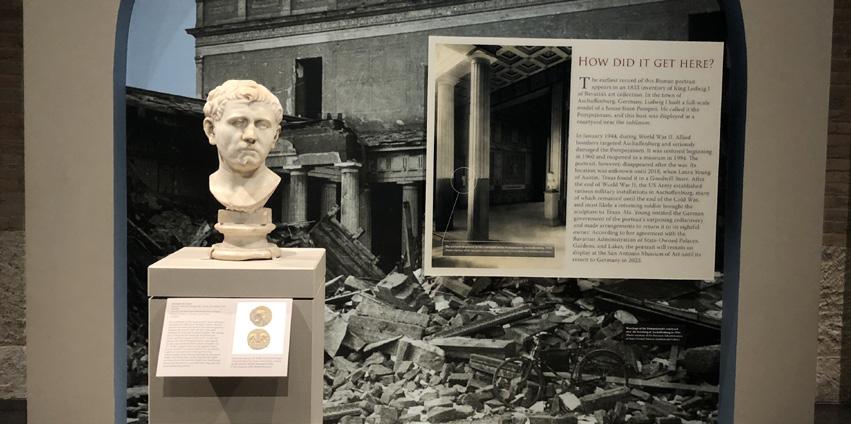
The ‘Runner is a free shuttle service provided by UTSA that transports students to and from several stops in the vicinity of the university directly to campus. This includes student apart ments, Resident Lot 5, Bracken ridge lots 3, 4 and 5 as well as the East Campus and Barshop lots. Students are picked up and dropped off on campus at bus stops located outside the North Paseo Building and the Science and Engineering Building.
Students utilize The ‘Run ner for several reasons, but the primary rationale, as expressed by senior Jessica Romero, is the system’s convenience.
“Well for one, I don’t have the permit because it costs a lot of money and I don’t want to pay that,” Romero said. “So it liter ally gets me to school every day and back home.”
A similar sentiment is also shared by Clay Haverland, as sistant vice president for Campus Services, who discussed the ease of using The ‘Runner buses.
“Riding The ‘Runner is an easy and convenient transporta tion option,” Haverland said.
“Students who take The ‘Run ner to campus spend less time looking for parking and walking to class. By leaving their vehicle at home, they also save wear and tear on their vehicle.”
Another reason students rely on The ‘Runner is because of safety. Students who park in one of the lots farther from campus, such as the East Campus Lots
or Brackenridge Lot 5, find themselves depending on The ‘Runner to get from the main part of campus back to their cars rather than having to walk — especially if they are on campus late into the night.
“I normally do take it [The ‘Runner] on Mondays and Wednesdays because it’s getting dark earlier and I don’t get out of here till like 7:45, and I don’t want to walk in the dark,” junior Melody Oropeza said.
However, despite the ease sev eral students have experienced with The ‘Runner, there are still some issues students have found with the bus system. For instance, when routes are com bined, a significant amount of time is added onto the bus trips.
Senior Maggie Flynn discusses this in more detail.
“I also just think that the routes take really long, especial ly when they combine them, that takes even longer,” Flynn said.
“I feel like these shuttle trips should be like five to 10 minutes, but when you combine them it’s like a 20-minute ride.”
Haverland describes the reasoning behind the combina tion of various bus routes, citing examples such as the number of passengers and traffic patterns.
“Route combinations are based on passenger counts and traffic patterns,” Haverland said. “We combine routes during times of very low ridership, such as early morning and late evening, to ensure minimal impact to pas sengers and route frequency. By doing this, we help ensure our
operations remain sustainable and efficient.”
Another key issue students have regarding The ‘Runner is the functionality of its app. UTSA The ‘Runner is an app that tells students what routes are available, where buses are along their routes and approximately what time the bus will be arriv ing at a given stop.
When discussing issues with the bus system, graduate student Jinjin Leu’s only problem was with the app.
“The only thing is sometimes the app is weird,” Leu said.
On the app, there is a tab labeled “Provide App Feedback” where users can provide insight and suggestions to improve per formance. Haverland discussed where this feedback goes, as well as the recommended way for providing suggestions regard ing the app.
“‘Provide App Feedback,’ found in the ‘About’ section of the app, is intended for feedback on the app’s performance and programming so these emails go directly to the app provider, a third-party company,” Haverland said. “To share feedback or sug gestions regarding The ‘Runner, contact Campus Services … we welcome and value Roadrunners’ feedback for ways we can im prove the app, and we carefully review and consider all sugges tions received.”
For issues and suggestions regarding The ‘Runner shuttle system, contact Campus Services at campusservices@utsa.edu or (210) 458-7275.
The Paisano reached out to LT Robinson for comment about plans to reopen the center.

“We are currently developing a robust suite of services, includ ing the possibility of multiple childcare location options, to assist with meeting the vary ing needs of student-parents,” Robinson said. “Additionally, we expect to offer a financial support pilot program for UTSA
from
1
student-parents starting in Jan. 2023, pending approval from the U.S. Department of Education.”
“We are tentatively scheduled to announce Phase 1 of our plan in Dec. 2022 to align with our pilot program application launch [and] also plan to collect student-parent feedback in the early part of the spring semes ter,” Robinson added.
“They use our openness as a vulnerability to attack us for a variety of purposes … and so, cybersecurity is vitally important to our country, to our state and to the world — to the democracies in the world.”
Referring to cyber security as a “modern challenge,” Cornyn went on to talk about the role UTSA is playing in developing and promoting cybersecurity curriculum.
“And the critical role UTSA will continue to play, not only as an institution that convenes all these various elements that are critical to cyber preparedness, but also to prepare the students for the workforce of tomorrow,” Cornyn said. “These are highly skilled jobs. They are not mini mum-wage jobs. They pay very well, but we don’t have enough qualified people to perform these
jobs and so that’s why the work being done here at UTSA is so critical.”
Cornyn further expressed the importance of collaboration between higher education, the private sector and the govern ment regarding cyber security, adding that he hopes the new legislation will further promote this collaboration.
“It’s really impressive to me to see what San Antonio’s been able to do — [to] attract the airforce, to attract the national security agency, but also to see UTSA build a world-class education system and encourage the kind of collaboration that is absolutely necessary between the government, between higher education, between the private sector — in order to deal with this threat,” Cornyn said.
By Gauri Raje News EditorFollowing the cold front predicted on Sunday, Oct. 16, the National Weather Service predicts temperatures as low as 51 degrees can be expected on Wednesday, Oct. 19; however, temperatures should rise into the high 70s starting Thursday, Oct. 20.
Ukrainian San Antonio came together for a rally on Satur day, Oct. 15, as a part of the “Circle of Defense” campaign. Similar events and rallies for the campaign were held by other groups across the country. The campaign was said to symbolize how Ukrainians are “defending the values of the civilized world in the frontlines.”
Over the weekend, the San Antonio Walk to End Alzheim er’s was held at Six Flags Fiesta Texas to honor those that have been affected.
An altercation on the city’s Northside led to a shooting on Saturday, Oct. 15. Authorities explained that the victim was hanging out outside his apart
ment complex when a group of people walked up to him and confronted him. This led to an argument, which ended with the man being shot in the leg. The man was taken to University Hospital in stable condition, and the suspects have not yet been identified.
Two people were held at gunpoint during an attempted robbery on Saturday, Oct. 15 at San Pedro Ave. The individu als, aged 27 and 29 years old, attempted to purchase a vehicle from Facebook Marketplace and fell victim to the crime.
On Friday, Oct. 14, a fire broke out at a downtown build ing. The building had at least seven apartments inside it, and residents were left displaced.
The fire was reported to have been coming from the back of the house undergoing a remodel, and spread to the attic. The fire crew on site was able to control the flames within 15 minutes. While no one was injured, dam age inside the apartments was “extensive.”
“To the first-gen students there — this is different. It’s a differ ent path, but learn [and] em brace that. Embrace the fact that you’re walking into a room and you don’t know as much as the people in the room. But you’re going to grow and you’re going to look at that as a challenge. If I quit eight weeks in, I wouldn’t be advising the president of the United States,” Cardona said.
Today, Cardona is part of one of the most diverse presidential cabinets in the history of the country, which includes several women and people of color. Cardona acknowledged this fact, adding that the administration is “delivering for the Latino com munity.”
In the field of education, Cardona highlighted some of the administration’s key policies that have benefited underserved com munities and first-gen students.
At the top of this list was the $130 billion that was allocated to K-12 education institutions as a part of President Biden’s American Rescue Plan. Cardona explained the importance of the money in the context of provid ing aid to communities that were hit harder during the pandemic due to a lack of resources.
w“We provided $130 billion for K-12 education institutions because we know [the La tino community was] impacted significantly by the pandemic,” Cardona said. “Everybody was hit — [the Latino community] and Black and Brown folks were hit a lot … folks that were in communities that don’t have a lot of resources were hit harder. So we made sure the money went to address achievement disparities.”
Cardona further explained that, since he assumed his posi tion, a more significant percent age of American schools have opened full-time, a direct benefit of the aforementioned $130 billion.
“When I came in, only 47% of
Continued from
our schools were open full-time across the country … within nine months we had over 97% percent of our schools open full-time, thanks to the American Rescue plan dollars,” Cardona said.
Another important policy Cardona discussed was Biden’s recent debt relief plan, which is aimed at taking off the burden of student loans that many Ameri cans continue to pay back. The relief plan will forgive $10,000 in student loans for all eligible individuals and $20,000 for Pell grant recipients. According to Cardona, almost every one in two Latino borrowers will be positively impacted by this plan, and this could also have an im pact on not just first-generation students but also their children’s access to higher education.
“For [the Latino commu nity], nearly one in two … with student debt are gonna see their balances drop to zero when they apply,” Cardona said.
Despite that, Cardona ac knowledged that debt relief is not the end-all and be-all when it comes to making college afford able in the U.S.
“Debt relief is not gonna fix the problem of having college be out of reach for so many people … it’s gonna help those who have loans, but we have to fix a broken system,” Cardona said. “But what we’re trying to do now is work with our colleges, work with our universities. Let’s work together to figure out how we could provide a better return on investment [and] ensure that college costs are reigned in so that students can afford them.”
Cardona also talked about the impact of the Higher Educa tion Emergency Relief Fund (HEERF), part of which is aimed at providing support to universi ties in keeping various programs open, which could potentially impact access to mental health.
Other points highlighted by Cardona included the impor
tance of state funding for higher education as well as teacher re tention, including better working conditions and salaries, given the important role that K-12 plays in a student’s educational journey. Cardona also talked about the importance of teacher prepara tion and how such programs would benefit from collaboration between higher education and K-12 institutions.
All of the points highlighted by Cardona tied back to the common theme of student suc cess and helping students from underserved communities.
Cardona circled back to the impact UTSA has as a Hispanic Serving Institution as well as in promoting faculty diversity. He explained that the university ranking system that currently exists fails to recognize the role that universities like UTSA play in helping students grow and provide upward mobility.
“I want to start lifting up col leges … that see the potential in … students when the students don’t even see it sometimes,” Cardona said. “I want to em brace universities and leaders that are seeking students that maybe the K-12 system didn’t serve well or maybe those students [that] have a level of resilience because they have to be helping provide food for their family or struggling with a lot of things that first generation fami lies like my parents did. To me, I want to embrace those universi ties that are taking students and helping them grow and provide upward mobility. That’s what I want to lift up as secretary of education.”
“It’s not either-or,” Cardona said. “[UTSA is] an R1 institu tion, yet you’re a model for what colleges can do to lift up students from Hispanic back grounds or maybe students that don’t fit a traditional college entrance process … you can do both, and that’s why I’m here with you today.”
On Oct. 6, the Texas Organizing Project (TOP) officially filed a lawsuit against Bexar County and the Bexar County Elec tions Office. The lawsuit was filed due to the number of polling places within Bexar County and claimed that this year’s midterm elections will have the low est number of polling places the county will have ever seen during a general election.
In 2020, a similar lawsuit was filed by TOP and MOVE Texas over the number of polling places.
Bexar County originally planned for 284 polling places, but after losing the suit, the number was increased. This year Bexar County initially approved 259, a considerable decrease from years prior.
After the lawsuit was initially filed, Judge Martha Tanner ruled that Bexar County must add approxi mately 129 polling places ahead of the election.
According to Texas voting laws, a county must have half as many voting places as they have districts.

With Bexar County having 776 precincts, that means
they must accommodate a minimum of 388 polling stations.
within their penal system convicted for these petty offenses.
By Malaki Lingg Assistant Web and Social EditorOn Oct. 6, President Joe Biden issued a presidential proclamation pardoning federal convictions for pos session of marijuana. The pardon only affects federal convictions and convic tions from the District of Columbia, which means the majority of those arrested for possession within the U.S. will be excluded. With the war on drugs spanning from the 1970s to the present day as well as the effort for federal nationwide legalization, is this enough action?
According to federal officials, approximately 6,500 incarcerated individuals would be released and have their drug convictions stricken from their records under the federal pardon. While this may be viewed as a signifi cant win for those fighting for mari juana legalization and the release of those incarcerated for petty possession offenses, it does not reach far enough.
If you consider the fact that African Americans are nearly four times more likely to be arrested for marijuana possession, a dangerous picture is displayed. While usage is roughly the same between white and Black men, Black men are arrested at dispropor tionate rates. According to a report by the National Organization for the Reform of Marijuana Laws, African Americans comprised approximately 30.2% of all marijuana arrests within the state of Texas while only account ing for 12.9% of the population.
Across the nation, thousands of men of color are serving time for nonviolent drug offenses, many of whom live in states where marijuana is legal or where legalization is underway.
Even in Texas, where cannabis has not been legalized, Delta-8 — a “legal” and lower THC form of cannabis — is currently being sold in stores, yet many are still serving time in state prisons. Anti-drug legislation has negatively af fected minority communities for years, and the nation continues to perpetuate that fact.
Close to half of all drug arrests are related to marijuana. Multiple states, such as California and Colorado, have legalized the recreational and medicinal use of marijuana. The disgusting reality is that the majority still have citizens
CommentaryPresident Biden’s pardon is not farreaching enough; we need conclusive action taken by our representatives to free those serving time nationwide; the fight for decriminalization is neces sary. The government — whether that be federal, state or local — continues to disproportionately affect minorities with its anti-drug legislation and then proceeds to take no action to help those arrested once they repeal such legisla tion. Our nation can do better.
By Jake Mireles Staff Writer
On Dec. 14, 2012, twenty-year-old Adam Lanza entered Sandy Hook El ementary School to commit one of the deadliest school shootings in Ameri can history. This is a fact and cannot be refuted; these events — as horrible and atrocious as they are — took place. Yet, there has been controversy surrounding the Sandy Hook shooting for the past decade. The families of the victims have been harassed online and in-person. Facts have been chal lenged and many conspiracy theories have emerged. These events have been instigated and perpetrated largely by one man: Alex Jones.
Host of the viral conservative talk show “InfoWars,” Jones is a widely known far-right commentator. He has accrued a mass audience by covering current events and the conspiracies surrounding them. Jones has covered an extensive amount of “news” ranging from election fraud to chemicals in the
elections up to statewide standards, yet the county is barely receiving any backlash or punishment. Even with the increase of polling places due to Judge Tanner’s ruling, Bexar County will still be under the minimum state-specified guidelines for the accept able number of polling places per county.
Throughout Texas, voters are experiencing some of the most blatant attacks of voter suppression in mod ern times. Alongside Bexar County’s failures, Texas has no online voter registration, limits the number of people who can vote by mail, has stringent voter ID laws and much more under Senate Bill 1.
Bexar County and the state of Texas are failing you as a voter and a citizen. As citizens, we must vote and protect our rights, and it just so happens that our right to vote and its credibility are at stake.
Check if you are registered to vote at https://www. vote.org/. Early voting begins on Oct. 24 and runs until Nov. 4, and Election Day takes place on Nov. 8.

Climate change is largely considered to be one of the most important issues of this generation. Even though it has been overshadowed by more recent political developments, such as abortion rights, student debt, etc., climate change will not wait for us to get our affairs in order before wreaking havoc. We already see the effects displayed through an increasing amount of tropical storms, droughts and wildfires. These weather phenomena will only continue to grow in severity and cause more damage to affected communities in the future. And while we may not be able to stop it completely, our window for preparing for these events in advance is quickly closing.
As the climate situation only continues to grow more extreme, it is important to vote for politicians who believe in the science behind climate
drinking water supply, and has made a fortune selling dietary supplements and doomsday-preparation equipment while doing it.
His most popular conspiracies and rhetoric involve painting major trag edies in American history, like Sandy Hook, as “false flags” conducted by secretive government organizations. One of the most damaging elements of his rhetoric, however, is his blatant and unapologetic use of misinformation and reporting uncorroborated information to his audience during live coverage of developing events. One of these incidents occurred during his coverage of the Parkland shooting in 2018, when Jones misidentified the shooter as a Massachusetts business owner who was completely unrelated to the developing situation. Later, Jones continued this narrative by labeling the misidentified man as a “communist,” per the South ern Poverty Law Center. This consis tent use of blatant misinformation and fiery rhetoric to galvanize his audience into taking action based on his words has led to one of the highest-profile civil suits in American history.
Since his original coverage of the massacre in 2012, Jones has painted the school shooting at Sandy Hook as a “false flag.” He has labeled the parents of the victims as “crisis actors” and has
change, and are willing to do something about it. It is easy for those who are running for office to use this issue as a way to get young voters to cast their ballot in their favor, but little ever actually comes from those empty campaign promises. These older representatives that we keep voting for hardly ever care for the consequences of climate change because, in their minds, the everwarming climate is a future issue that we will not be feeling the effects of for decades, and the future is
lives by the time climate change crosses the point of no return, leaving the younger generations to deal with the repercussions.
not their problem. The ones ignoring the climate issue are the ones who will not be suffering the consequences of their negligence.
According to the Library of Congress, the average age of Congressional Representatives is 58 years old, and Senators are 64 years old. These people will have lived long and fulfilled
As young voters, we need to support candidates that not only care about the future of our planet, and humanity as a whole, but those who will actually make an effort to prepare communities for the inevitable. It is too late to put the climate change cycle back on its natural course since humans have increased carbon dioxide levels by about 50% since the 1700s and there is no way to effectively reverse the damage done now, but preparations can be made to help sustain the populations likely to be the most severely impacted by the changing climate and the extreme weather that comes with it. We need politicians who want to help the people — especially the younger generations — adapt to this massive change that is happening within our lifetimes. As voters, it is our responsibility to research candidates and hold them accountable because they hold our future in their hands.


accused the event of being staged to promote anti-gun legislation. His con sistency and reinforcement of this posi tion over many years has caused some members of his audience to go out and harass the victims’ families both online and in-person. One of the former contributors to “InfoWars,” Wolfgang Halbig, was even arrested in Florida for “unlawful possession of personal infor mation” and was accused of harassing Leonard Pozner, a parent of one of the victims, according to ABC. These events have led a coalition of families to mount a number of civil suits against Jones and “InfoWars.” These lawsuits have been largely successful, and most recently the eight families have been awarded nearly $1 billion in damages by a Connecticut jury per The New York Times.
While Jones’ rhetoric is danger ous, what is more concerning is the conservative movement’s willingness to accept and defend him. Since the damage awards trial was concluded, many popular conservative pundits have come out in defense of Jones. In a Tweet, leader of the conservative youth outreach organization Turning Point USA, Charlie Kirk stated, “This isn’t about calculating real damages from Alex Jones. This is about sending a message: if you upset the Regime,
they will destroy you. Completely, and utterly, forever.” Popular conservative broadcaster Steven Crowder hosted an exclusive interview with Jones, where he paints the trial as the government’s attempt to silence yet another conser vative speaker. The far-right’s attempts to essentially martyrize Jones through this process is extremely troubling.
Jones has undeniably incited violence and harassment towards families who have already lost so much. His claims are not based in fact, yet many con servatives refuse to condemn him and distance themselves from his rhetoric. Instead, they have welcomed him into the fold with open arms.
Jones is not a martyr, he is a conartist who made money inciting violence against families of school shooting victims. He has no place in legitimate political discourse and his claims should be rejected outright.
Instead, Jones’ positions are becoming more widely accepted and advertised. This is unacceptable and indicative of how misinformation combined with inciting rhetoric can harm society if left unchecked.
“ half of all drug arrests are related to marijuana ”
“[Alex] Jones is not a martyr ”
After spending nearly 23 years in prison, Adnan Syed is now a free man. Syed, the subject of the hit podcast “Serial,” was convicted in 2000 for the 1999 murder of Hae Min Lee. Ac cording to NPR, his release occurred due to prosecutors violating the Brady rule, which requires prosecutors to turn over any evidence that could help the defense. Unfortunately, Syed’s case is an exception to the rule. Wrongful convictions are not easy to overturn, and the Supreme Court might make it even harder.
The National Registry of Exonera tions, a project launched in 2012, aims to provide reliable data and informa tion on the exonerations of innocent criminal defendants. Their findings alone are staggering. The Registry recorded 161 exonerations in 2021. At least 102 of those exonerations in volved official misconduct. The project defines official misconduct as “Police, prosecutors, or other government of ficials [who have] significantly abused their authority or the judicial process in a manner that contributed to the exoneree’s conviction.” Fifty-nine of the cases marred by official misconduct were homicide cases.
Exonerees lost an average of 11.5 years of their lives due to wrongful imprisonment. As a result of someone’s improper actions, innocent people lost at least a decade of their life behind
bars. These statistics do not include people who died serving their sentences or who are waiting for an appeal. It is already an uphill battle trying to get a conviction overturned. Reed v. Goertz might change that.
The state of Texas is about to execute Rodney Reed for capital murder. Reed claims he is innocent and believes postconviction DNA testing could prove his innocence. The Supreme Court is hearing his case, but not for the reason you might expect. It is over whether he filed his legal claims in time.
Reed, a Black male, was convicted by an all-white jury of the 1996 murder of 19-year-old Stacey Stites, a white female. According to CNN, investiga tors targeted Reed because they found his DNA inside of her. The problem is Reed wants the belt used to kill Stites to be tested for DNA. He was denied by a state court, despite a Texas law that allows a convicted person to obtain post-conviction DNA testing. Reed is now arguing this denial violates his rights to due process; however, a fed eral appeals court held Reed had waited too long. This would essentially give Reed a deadline that he failed to meet.
The Supreme Court’s potential ruling could create an even more significant obstacle for people affected by wrong ful convictions. If there is evidence that contains traces of DNA, it should be tested to ensure the correct suspect was apprehended. However, enforcing a deadline is harmful, especially when new evidence may emerge. Who deter
mines when it starts? How long would it take? Would it vary state by state? Reed’s case is disturbing because he claims there’s evidence that casts suspicion on another suspect: Stites’ fiancé, Jimmy Fennell. Reed could be guilty of Stites’ death, but why doesn’t the state of Texas try to ensure they have got the right man? Testing the belt for DNA would remove any reasonable doubt about who the perpetrator is. Re fusing to do so would be a miscarriage of justice. Botched investigations harm not only the wrongfully convicted but also the victims’ families.
Imagine believing that the prosecu tion conducted a full investigation in your loved one’s death, but you find out they convicted the wrong person years later. Or even worse, the correct person might have been caught but then released due to prosecutorial misconduct. Unfortunately, this is the reality for Hae Min Lee’s family.
“Going through it again is like a liv ing nightmare,” Young Lee, Hae Min Lee’s brother, said during the hearing to vacate Syed’s conviction.
Blindsided by the system they trusted, there is no reassurance for the Lees. The nightmare continues for them every day. Sadly, the prosecution likely will not be held accountable for the irreparable damage they have done to the Lees and Syed. Nothing can make up for years of suffering as trauma still lingers.
Originality: Everyone likes to think they are unique and special, but the sad truth is that billions of people have come before us and billions will come after. Yet individual humans are still special. What makes people unique is experi ence, the place where new ideas and concepts are born. Experience is what shapes the world of every indi vidual, and a person’s views and values often reflect their individual experiences.
With the world being more connected than ever and ideas being shared on line in a matter of seconds, people are generally welleducated on topics like poli tics and current events. Yet the connections provided by the internet have also led to mass consumption of brain less content that is seem ingly endless. Think about it — how many TikTok or
YouTube creators make nearly identical videos because they are profitable and safe? The dumbing down of ideas to appeal to
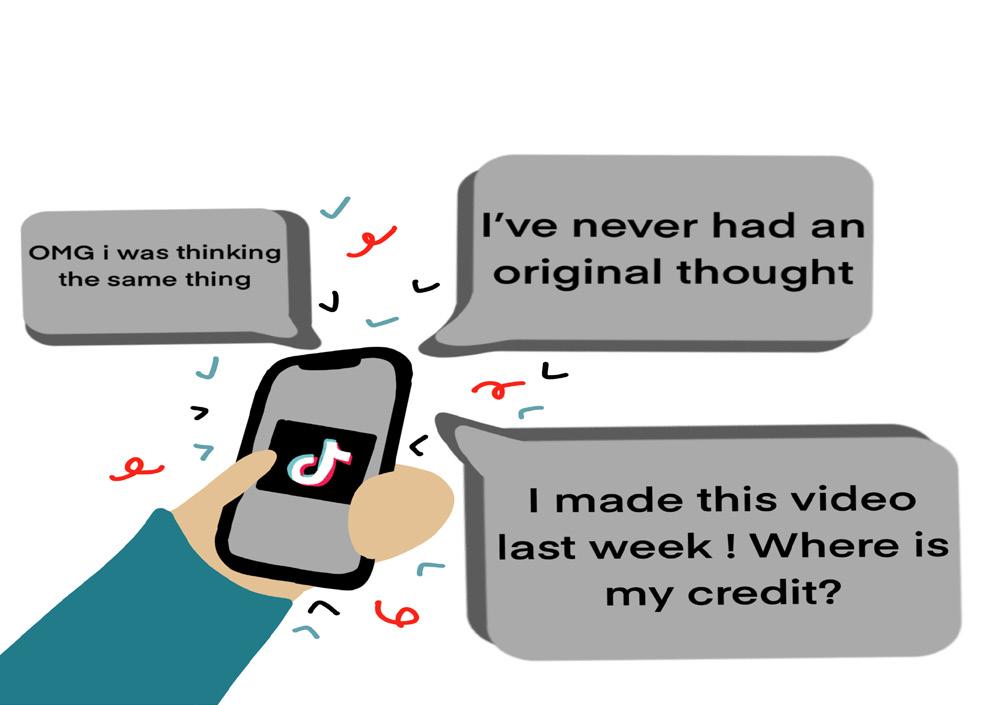
movies, there will always be more. Something similar is happening on social media, where content is pumped out by the millions
the masses is nothing new. Within all forms of entertainment there will be products created with mass appeal in mind. An example of this is the recent craze surrounding super hero movies. As long as the masses want superhero
every hour. With so much content, the development of online trends is nothing surprising. These online trends result in thousands of users creating similar con tent to be a part of whatever the current trend is. While these examples might lead
to the assumption that social media is killing originality, they can also be examples of how the internet has al lowed for more ideas and concepts to reach more people than ever before. What one chooses to do with the content presented to them is impossible to predict. Some might copy the content and claim it as their own, while others could be inspired to create something original. The determining factor in what one does is largely through the experiences they have gathered throughout their life. So there will always be new ideas as long as hu mans are around, and those who choose to consume and copy will also be around. These truths reflect the special and unique aspects of everyone to ever walk the earth.
In the fight for Ukraine’s freedom, one of the most vital tools being used by the Ukrainian military has been Starlink.
Created by Elon Musk’s space development com pany SpaceX, Starlink is a satellite network used to provide high-speed broad band internet to many regions of the planet. Since its arrival late last spring, Starlink has been a vital element for Ukraine’s quick and light military tactics, and the country has relied heavily on its use to achieve success on the battlefield due to the destruction of the nation’s existing cellular and inter net service infrastructure. This service also came very close to stopping cov erage in Ukraine but for vastly different reasons.
Elon Musk is a billion aire who has garnered a large following on many social media platforms and is known for being the owner of Tesla, SpaceX,
the Boring Company and possibly Twitter. One thing he is not, however, is an expert on international re lations. Despite this, Elon Musk has had conversa tions with both Ukrainian government officials and Russian President Vladi mir Putin, firmly inserting himself in the midst of a geopolitical conflict in which he arguably has no place. This has not kept him from very publicly voicing his opinion on how the war should be settled to a very large audience, catching the at tention of many Ukrainian and Russian officials. In a Tweet, Musk proposed a peace agreement with four key steps: Redo Russian referendums of annexed regions with UN supervi sion, formally recognize Crimea as a part of Russia, ensure water supply to Crimea is restored by the Ukrainian government and that Ukraine remains neutral. The proposition was quickly dismissed by both the Twitter users that
voted in his poll, as well as Ukrainian officials.
Soon after these de velopments, CNN ran an article covering a let ter they obtained from SpaceX to the Pentagon.
In the letter, SpaceX expressed that they were “not in a position to donate further terminals to Ukraine, or fund the existing terminals for an indefinite period of time,” according to SpaceX’s director of government sales. SpaceX then asked the Pentagon to foot the bill for Starlink operations in Ukraine, threatening to end their contribution to the project. According to a Tweet, Musk claimed that “This operation has cost SpaceX [$80 million] & will exceed [$100 million] by [the end of the year],” despite a Washington Post investigation revealing the U.S. Government has spent millions of taxpayer dollars to send Starlink terminals to Ukraine. This conflicts with Musk’s statements on the matter
and has cast doubt on if SpaceX really foots the entire $80 million bill.
The developing situa tion with Starlink high lights a large flaw in the way Ukraine — and many other nations — govern. Relying on private, forprofit organizations and billionaires to provide essential services in many sectors can lead to grave consequences. They are not beholden to the wellbeing of those who depend on their vital services, but only to their own personal profit. Ukraine came very close to losing an in strumental tool at their dis posal because they relied too heavily on the gen erosity of one unelected, profit-driven individual.
This has happened count less times throughout history and will continue to happen. The world can not rely on billionaires as necessary components of our existence.
Mason Hickok | Editor-in-Chief Editor@paisano-online.com
Laynie Clark | Managing and Opinion Editor Manager@paisano-online.com and Opinion@paisano-online.com
Gauri Raje | News Editor News@paisano-online.com
Riley Carroll | Arts & Life Editor Arts@paisano-online.com
Luke Lawhorn | Sports Editor Sports@paisano-online.com
Kaitlyn Rosas | Multimedia Editor Multimedia@paisano-online.com
Chloe Williams | Web and Social Editor Web@paisano-online.com and Socialmedia@paisano-online.com
Camila Martinez Rivera | Photo Editor Photo@paisano-online.com
Business Luke DeMario | Business Manager Business@paisano-online.com
Malaki Lingg | Assistant Web and Social Editor
Jessica McLaren | Assistant News Editor
William Barnes | Assistant Multimedia Editor
Marcela “Mars” Soria | Assistant Multimedia Editor
Dustin Vickers | Assistant Photo Editor
Grace Robinson | Assistant Photo Editor
Staff
Nate Henneke | Staff
Maddie Cortez | Staff
Dafny Flores | Staff Eric Trevino | Staff Guissel Mora | Staff
Jada Thomas | Staff
Regina Robert | Staff Alex Fotschky | Staff
Zahara Latson | Staff Misty Olawunmi | Staff
Stephen Saenz | Staff
Jenna Taylor | Staff
Genevieve Vega | Staff Jake Mireles | Staff Caroline Puckett | Staff Kara Lee | Staff Cesar Soto | Staff
manager@paisano-online.com
Diane
Stefanie
The Paisano is published by the Paisano Educational Trust, a non-profit, tax exempt, educational organization. The Paisano is operated by members of the Student Newspaper Association, a registered student organization. The Paisano is NOT sponsored, financed or endorsed by UTSA. New issues are published every Tuesday during the fall and spring semesters, excluding holidays and exam periods. The Paisano is distributed on the UTSA Main Campus. Additionally, Paisano publications are distributed at a variety of off-campus locations, including Tri-point and a variety of apartment complexes near the UTSA Main Campus. All revenues are generated through advertising and donations. Advertising inquiries and donations should be directed to: 14526 Roadrunner Way Suite 101 San Antonio, TX 78249 Phone: (210) 690-9301
© 2022 The Paisano
The University of Texas at San Antonio’s Handbook of Oper ating Procedures states in 5.03 that: The University of Texas at San Antonio (UTSA) will not exercise control over the format or content of Student Pub lications, but will regulate distribution on campus. Student Publications will be free of censorship and advance approval of copy, and their editors and managers are solely responsible for editorial and content policies and decisions. Editors and managers of Student Publications will not be subject to ar bitrary suspension/expulsion or removal from their positions within a Registered or Sponsored Student Organization (Student Organization) by the University because of student, faculty, administrative, or public disapproval of editorial pwolicy or content.
Organizations that distribute Student Publications are afforded the same rights and privileges as Student Organizations that do not distribute Student Publications.
San Antonio has a thriving local music scene full of genres such as country, metal, indie and most importantly, punk. As a genre, punk rock is described as an overt, loud, politi cal and DIY culture. Snail Society was founded with an accepting local scene and a love for custom goods.

Snail Society is a pop-up shop run by Kendall Hernandez. From selling at small venues such as Graffiti House to setting up shop at ditch shows, Snail Society is becoming a staple of the local music scene. Snail Society sells must-haves for the punk community like patches, pins, upcycled clothing and will even be pro ducing merchandise for bands such as @HerLoveBeheadsDaisies on Instagram.
“I started [Snail Society] because I was bored,” Hernandez said. “I’ve been a part of the music scene here [in San Antonio] for maybe like four or five years and was I already making stuff, so I was like f–k it, let’s do it.”
While Snail Society is currently DIY, using bleach to paint shirts and recycled paper to make stickers, Hernandez has dreams of expanding Snail Society’s ventures.
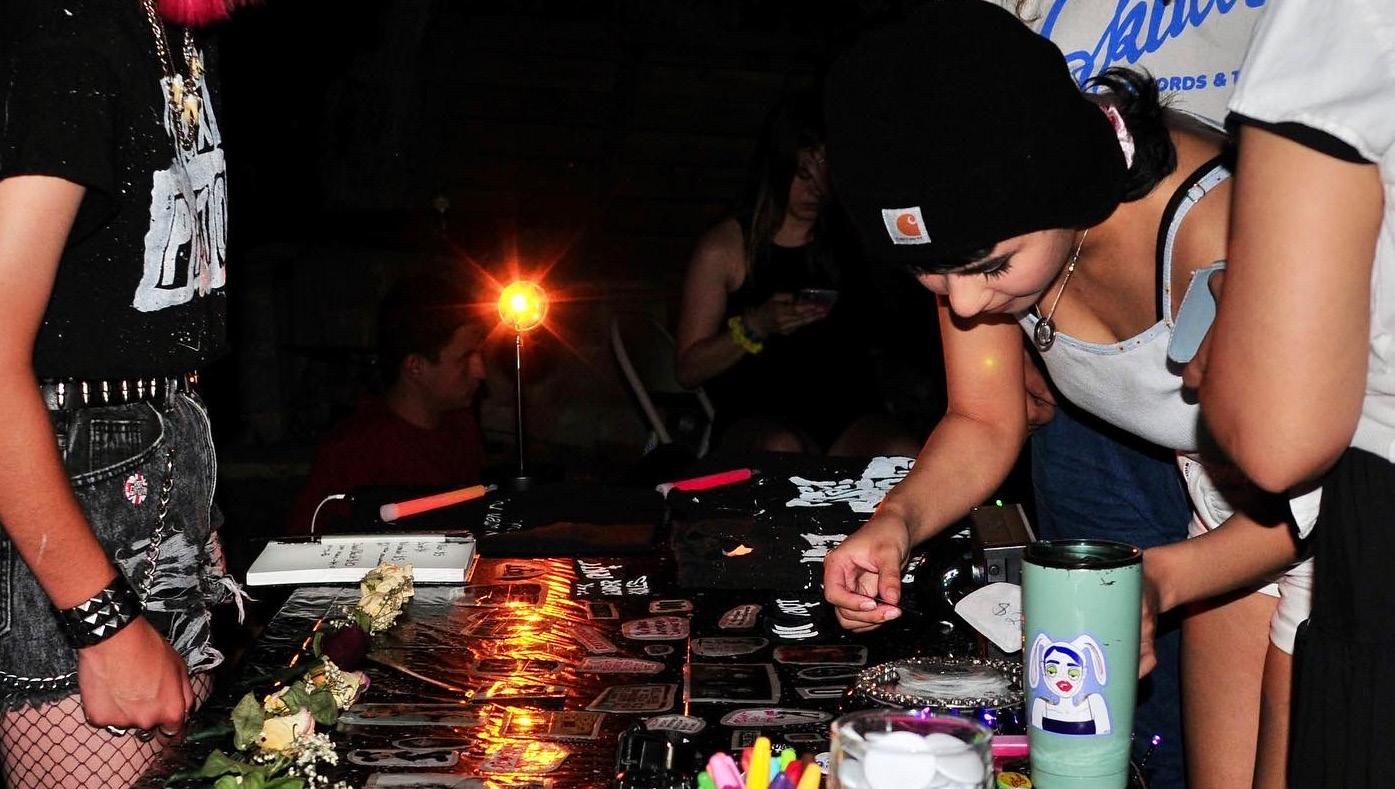
“I want to start screenprinting. I’ve been getting really into that, and I’ve been trying to make that happen,” Her nandez said. “I think expanding into real
printed shirts would be really cool. I’ve also been working on some cool stuff with flannels, so y’all will have to be on the lookout for that new stuff.”
With punk comes politics. Punk music is a heavily political and opinionated sphere of music, with stickers represent ing movements such as All Cops Are Bastards (ACAB), riot grrrl — a women-
led feminist punk subculture — and Eat the Rich. Hernandez and Snail Society stick to that closely.
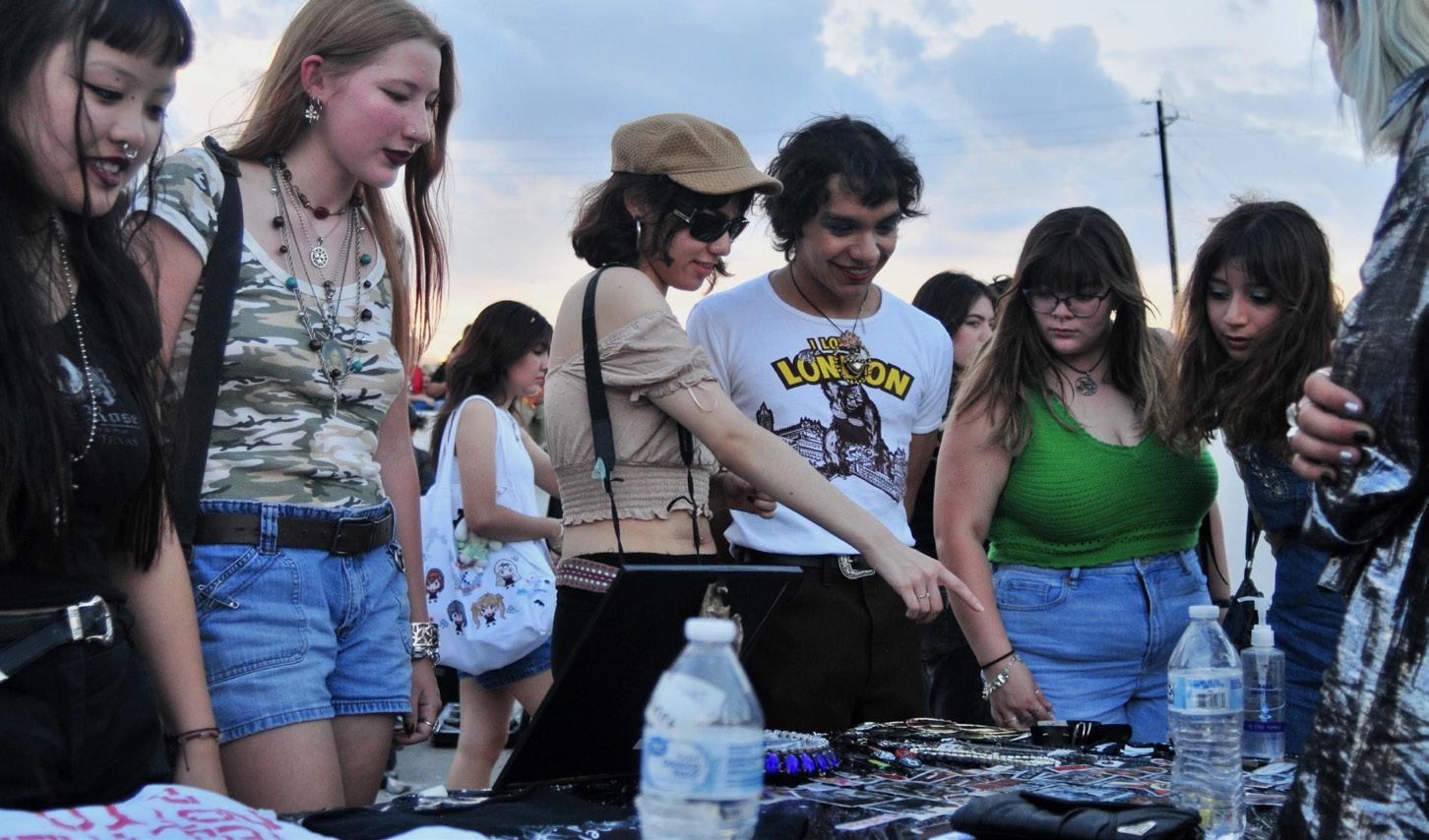
“I don’t really like cops, which I guess is kind [of] a punk thing. I support … [movements] like ACAB and Eat the Rich, and so do a lot of other [people] in the local scene,” Hernandez said. “I’m pretty political and I think it’s cool that I’m able to play into that with Snail Soci ety and my art. I think riot grrrl is dope. The message that the culture is trying to put out is something I heavily associate with. A lot of people say stuff like ‘punk and riot grrrl are dead,’ but I think it’s really making a comeback, and I’m here for it.”
For more information about Snail Soci ety, check out their Instagram @0_snail_ society_0. The next show Snail Society is attending will be held at 7:30 p.m on Oct. 22 at Nani Falcone Skatepark, 8701 Mystic Park, San Antonio, TX, 78254.
By Guissel Mora Staff WriterThe opera of “La Malinche: Traitor, Survivor” was com posed conjunctively with the exhibition titled, similarly, “Traitor, Survivor, Icon: The Malinche” at the San Antonio Museum of Art (SAMA) by Austin native Nathan Felix. He presented his immersive opera on Friday, Oct. 14, as part of Hispanic Heritage Month.
As Felix was busy gathering the final preparations for his opera, the audience bustled with anticipation of his production. Many compliments were heard from the crowd, some saying this event felt “very special, something that does not happen every day.” Just as the crowd was getting antsy, Stephanie O’Barr Garcia, SAMA’s public programs, diversity and inclu sion manager, introduced Felix. Following his introduction, he informed us about the program and thanked us for the opportu nity to present his work.
Felix is known for his guerrilla-style approach in his
works, so it was pleasant to hear him encourage the audience to get up and move around. But, the audience was too entranced by Celeste Morales, who played Malinche, as she lured the crowd towards her voice like a siren. She stepped into the great hall of SAMA, ap proaching her Aztec slaves, played by Emily Anderson and Lucianna As torga. Soon after their introductory scene, Hernán Cortés, played by Thomas Soto, advanced toward them.
The Aztec slaves declared him a monster as Cortés forcefully took Malinche. He held up his sword to stop their cries of agony; the slaves fled
the scene and handed off their weapons to audience members. Cortés’ voice beckoned to them.
the air were heard in the cellos’ repeated weary notes. Silence briefly ensued after all of the chaos and heart break from Ma linche’s slaves and herself. The cello and violin soon accompanied the si lence as they made sorrowful noises, which is when her slaves mark her as a traitor for leaving with Cortés. Just as their anger and betrayal build up, he reappears before Malinche, and they embrace one another.
when Cortés, along with his Spanish men, conquested, colo nized, raped and mistreated the indigenous people of Mexico.
Malinche then holds a knife to Cortes but does not strike him, reflecting on the events of her journey and internal conflict.
In modern-day, this could be described as Stockholm syn drome, but it was much more than that in the 16th century.
La Malinche, or Malitzin, was Cortés’ translator to Moctezuma II, an Aztec leader before the fall of his empire at Cortés’ hand.
As Cortés took Malinche, the fear and hesitation felt through
Soon a battle broke out between Cortés and the Aztec slaves. He conquered them, just as he did the rest of Mexico. The singers disappear, leaving behind their mark of Aztec resilience and sorrowful notes, all too-telling of the harsher reality in 1519,
Felix, his cast and the en semble portrayed the events that took place on indigenous land under Cortés’ conquest through his opera with great emotion.
They received a standing ova tion from the audience and rightfully deserved praise once the program concluded. The “La Malinche” exhibition will be displayed at SAMA through Jan. 8, 2023. To keep up with Felix and his works, visit his Insta gram @nathannoise.

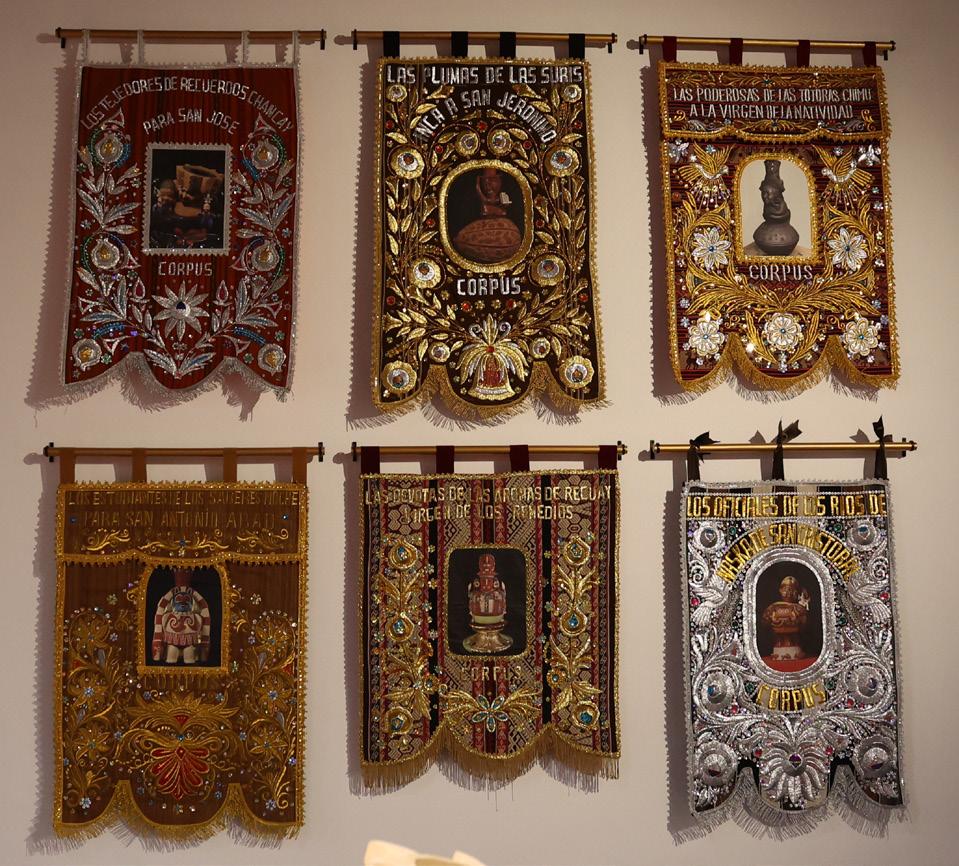
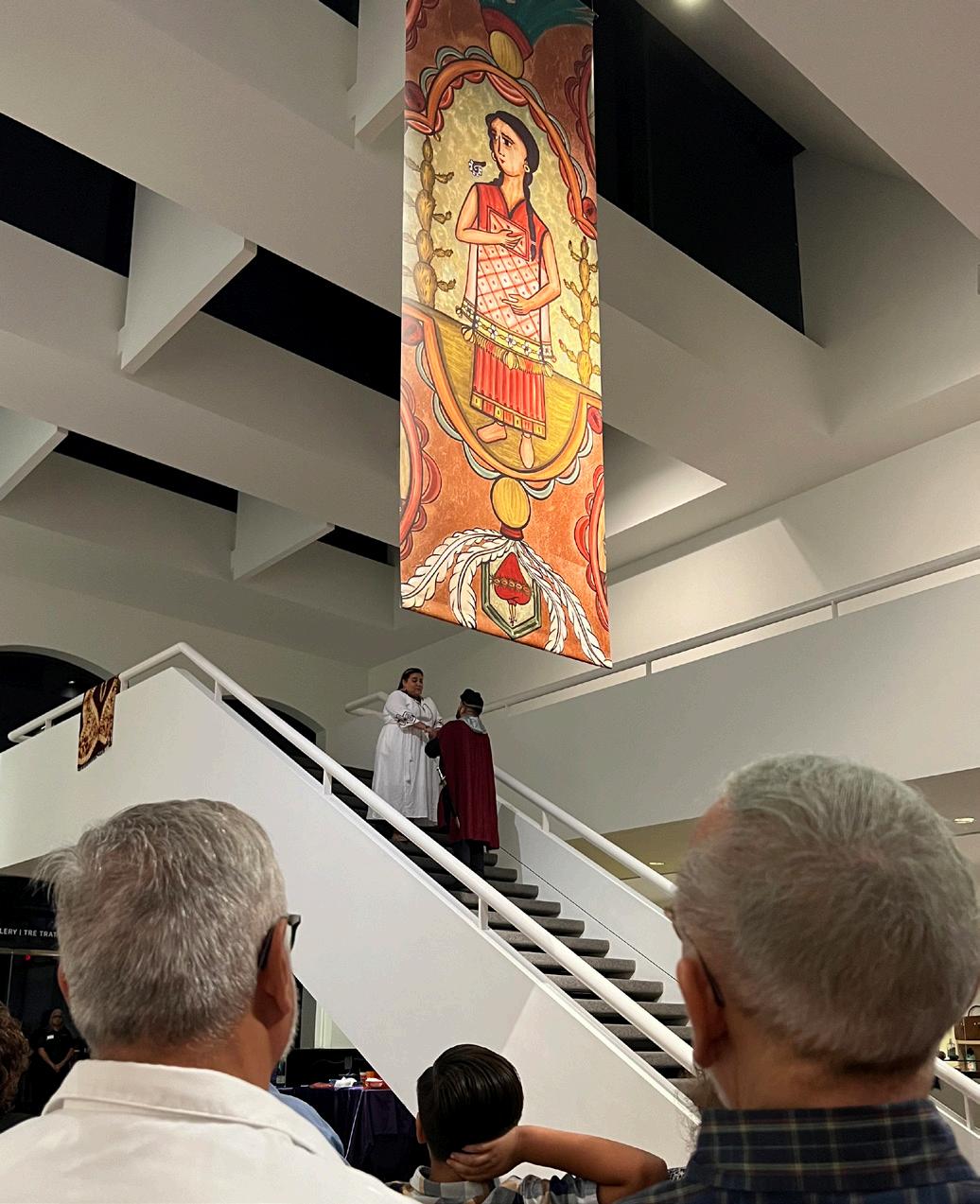
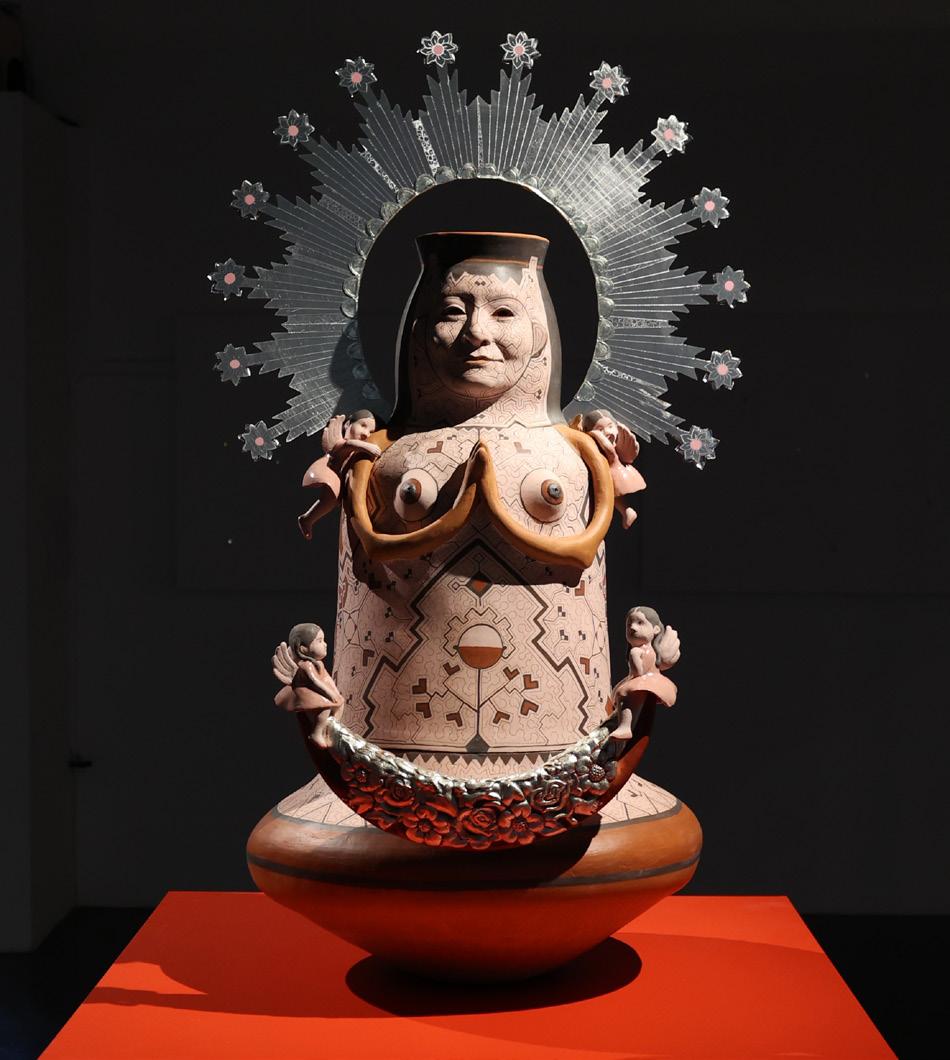
‘La Malinche: Traitor, Savior’
DIY punk patches, pins and paraphernalia An immersive opera performance with Nathan Felix
‘Snail Society’ pop-up shopLauren Hernandez/The Paisano Lauren Hernandez/The Paisano Guissel Mora/The Paisano Lauren Hernandez/The Paisano Snail Society customers gather around Hernandez’s pop-up. Branded stickers available at Snail Society’s table.
The iconic Roman bust on view at the San Antonio Museum of Art (SAMA) holds a compelling and mysterious story. In the fall of 2018, the bust — a sculpture representation of the upper section of the body — mysteri ously ended up at a local Goodwill in Austin, Texas, and was then purchased for $34.99 by Laura Young after it had not been recognized since the end of World War II. A consultant in Europe, who happened to have a photographic memory, remembered seeing the same bust in an old archive and decided to dig deeper into the sculpture’s origin.

Dr. Lynley McAlpine, a postdoctoral cu ratorial fellow at SAMA, mentions that after the bust was studied further, it was brought to the art department at The University of Texas at Austin (UT), where they held their regular archeologist conference. Here, they brought the bust into a lecture hall which was the first time people could study it together as a group due to COVID-19.
“The first time I saw it was on a table in the lecture hall on campus there,” Dr. McAl pine said. “And everyone agreed that it looks ancient Roman, you know, these are people who’ve looked at a lot of ancient Rome and it definitely looks ancient.”
In Jan. 2019, Jessica Powers, chief cura tor at SAMA, as well as Dr. McAlpine, were invited to Young’s house to take a final look at the bust because they knew it had to return to Germany at some point.
After conversations about shipping it back to Germany, they were hoping there would be a place to display it in Texas because it has this alluring “Texas story” tied to it.
“I’m just personally lucky that I got to be one of the first people to see it when Laura showed it at UT, and then I also got to see it for over a year in her house,” Dr. McAlpine explains.
There was no place for it at UT’s art museum, so Young got in touch with Curator Powers here at SAMA. After the long process of legal paperwork and verifying details about the bust — such as where in Germany it came from, who it is and how it ended up here — they were able to get it approved to be on view.
As for the details of the sculpture, it took about two years to determine who was de picted in the sculpture, where it came from and how it ended up in Austin.
“I’m not the first person to suggest this, but the identification that I think is the most likely is that it is a man who was called Sextus Pom pey,” Dr. McAlpine said.
“And suddenly, Hades was only a man.”
“Hadestown” has departed from Texas, but the feeling it left behind has not. The Tony Award-winning musical made its way to the Majestic Theatre on Sept. 13 and took its final bow in Austin, Texas, on Sept. 25 before traveling to Okla homa.
The musical is set in a hellish, climate change-stricken background of smogfilled air as an adaptation of the ancient Greek myth of Orpheus and Eurydice unfolds on stage. Hermes, played by Tony Award winner Levi Kreis, narrated the tale while simultaneously interacting in the scene.
The tale is not an unknown one: two lovers separated soon after igniting their spark. As Hermes explains the sad tale, Eurydice stumbles into a restaurant where she falls into the arms of Or pheus — a singer who is set on bringing warmth back into the world through song. After poverty strikes, Eurydice is approached by a devilish man — Hades, the God of the Underworld. Hades pres ents Eurydice with a choice: stay with Orpheus and live in poverty or leave him and follow Hades to the Underworld.
As the tale unfolds, various lighting designs are splayed on stage to convey the necessary emotions of the play. While Hades is constantly engrossed in a hue
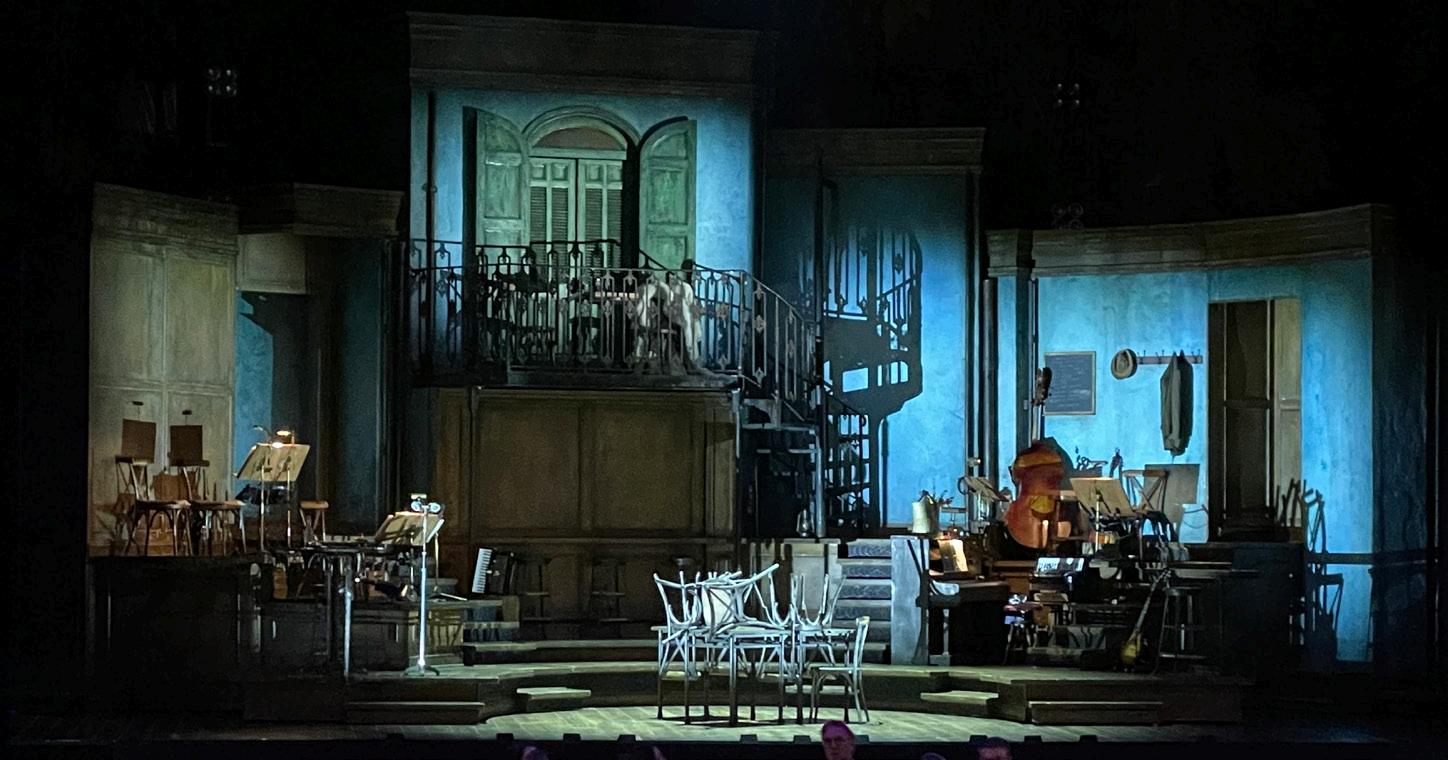
of warm tones to represent the heat of the Underworld, Orpheus is seen through dim, cool-toned lighting. It is no surprise that lighting played a key role in this show as Bradley King — a multi-award-winning lighting designer — spearheaded the design process. King utilized lighting in ways that made the audience feel like they were a part of the show rather than mere spectators.
Aside from lighting, Hadestown is recognized for its jazzy, acoustic sound, composed by Anaïs Mitchell. Tradition ally, bands are hidden away from the audience in a pit or backstage. Unlike other musicals, “Hadestown” has its band staged into the show and visible to the audience to fit the musical’s aesthet ic. This elevated the listening and view ing experience for the audience, which provided a deeper appreciation for the ensemble. Chibueze Ihumo had the honor of filling Orpheus’ shoes for this performance, and he did not disappoint. Taking the usual youthful sound from the original Broadway company, Ihumo brought a deeper, more soulful mean ing to each note he sang, considerably improving the flow of the soundtrack.
Director Rachel Chavkin smoothly executed the vision from soundtrack to stage, something not all directors can do. Chavkin left the audience yearn ing for more, understanding that not all stories have happy endings, making “Hadestown” a must-see musical.
However, this information is specula tive, as the sculpture does not depict an emperor, who would have been more favorable in Roman history. McAlpine continues to explain that rather than Sextus Pompey being an emperor, he was more of an enemy of the state and consid ered an outlaw. General Pompey the Great — Sextus Pompey’s father — fought in a civil war against General Julius Caesar, before he came into power in Rome. Caesar won the war, as Pompey the Great was essentially murdered. The Pompey sons wanted to continue Pompey the Great’s story and sought justice for their father’s death. Afterward, the Pompey sons, including Sextus, continued to fight against Caesar and his successors, ultimately leading to their deaths.
The bust is on view at SAMA until May of 2023. Afterward, the iconic Roman bust will be shipped back to its home in Germany. Although there is limited time remaining with the bust, it is valuable that it is on view here to honor the small piece of Texas history tied to it.
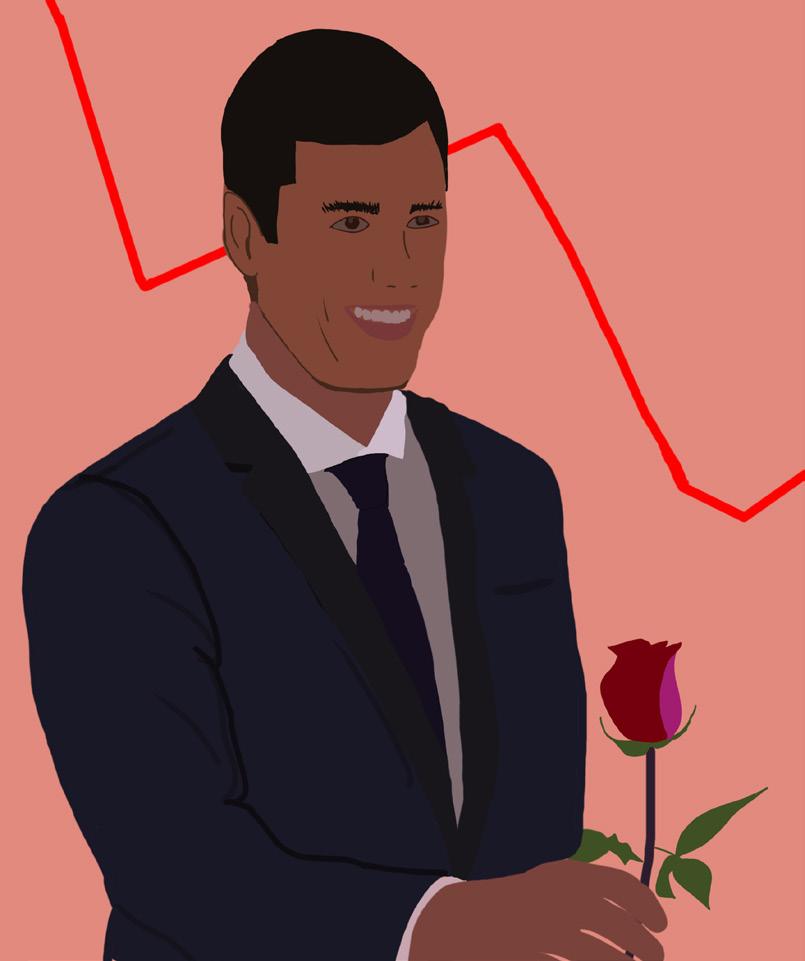
Some of you might have heard of the popular ABC dating shows — “The Bachelor,” “The Bachelor ette” and “Bachelor in Paradise.” “The Bachelor” consists of 30 women fighting for the engagement to one male fan favorite from a pre vious season. “The Bachelorette” is the same concept, with the roles reversed. “Bachelor in Paradise” is where men and women from either show all meet up on one beach and try to “find love” — one of the host’s many taglines.
“The Bachelor” first aired on March 25, 2002, and the firstever “Bachelorette” season aired shortly after on Jan. 8, 2003. “The Bachelor” franchise has never missed a season in its nearly 20-year run, includ ing during the COVID-19 pandemic. The show has been able to remain successful because of its large and loyal fanbase in which fans throw viewing parties, create fantasy drafts where they predict who will win and tune in every Monday to watch two hours of straight romance and drama. Regardless, the show has expe rienced much controversy that puts the ethics of the show into question.
“The Bachelor” franchise has been involved in many controversies including Chris Harrison, — the show’s host from 2001-2021 — who was fired from the
show after comments defending a racist contestant and not having a non-white Bachelor until 2020.
The show has received countless amounts of criticism for not diversify ing its cast as seasons progress. It is always the same blonde, skinny, straight, predominantly white cast. This becomes a more glaring contrast when one real izes that the show has never had a black couple standing at the end of any of the franchise’s seasons. The lack of diversity in terms of race, body size and sexuality excludes the vast majority and fails to accurately represent what the real world looks like.
The Witte Museum and Bracken ridge Park are inextricably linked, two gathering places central to San Antonio’s history. The Witte Museum sits on the park’s northern end right off Broad way. Opened in 1926 — under the guidance of Ellen Dorothy Schultz Quillin — the Witte has seen history and development, sharing much of that with Brackenridge Park.

Both are being celebrated with the release of Lewis
F. Fisher’s book “Brackenridge: San Antonio’s Acclaimed Urban Park,” out on Oct. 18 through Trinity University Press. The new exhibit at the Witte takes its name from Fisher’s forthcoming book on Brackenridge Park — an extensively researched look at the park through pic tures and historical findings. Those same pieces and archaeological discoveries will be presented to the public.
Marise McDermott is the CEO of the Witte Museum, a role she has held since 2004. McDermott spoke of the impor tance of working closely with Fisher on the exhibit. As a researcher, Fisher’s ties to the museum are closely linked.
Continue reading on paisano-online.com.

‘Hadestown’ is a must-see musical An entertaining show that severely lacks diversity
San Antonio
Witte Museum exhibit to highlight the history of Brackenridge ParkMason Hickok/The Paisano Photo courtesy of Witte Museum Arte de San Antonio
Aspredicted, the UTSA football team is atop the Conference USA (C-USA) standings with an overall record of 5-2. But most importantly, UTSA is 3-0 in C-USA play and tied with North Texas for first in the conference. The 2022 season is without an East and West division, meaning the championship game will be played against the top two teams in the overall conference standings.
UTSA had 14 first-place votes by members of the C-USA media to repeat as champions, which was most among other C-USA teams. However, there were questions about how the Roadrun ners would repeat. They lost key players such as Spencer Burford, Tariq Woolen and Sincere McCormick to the National Football League (NFL). Additionally, the
team had multiple running back injuries during the offseason, almost deeming this season over before it started. While continuing to battle injuries, UTSA is still number one in the conference, but how?
The Roadrunners are 16th in the country in total offense, led by Frank Harris, who is number one in all of college football for passing yards. The only other team from C-USA ahead of UTSA in total offense is Western Kentucky University, who the ‘Runners beat convincingly. North Texas — the other undefeated C-USA team — is 19th in total offense, deeming this next game UTSA’s toughest conference matchup. Though, the Roadrunners have answered with their running game. Thus far, UTSA has rushed for a total of 1,018 yards through seven games while opponents have rushed for 1,181 total yards on the Roadrunner defense. Though they are
In the final preparation before the conference meet, the UTSA cross country team traveled back to the Dale Watts Cross Country Course to partici pate in the Arturo Barrios Invitational. The men’s team managed to secure 20th in the 40-team field, while the women’s team achieved 30th in the 38-team field.
The men’s 8000-meter race began at 9 a.m., and the ‘Runners stormed off the starting line to fight for position. UTSA stayed consistent throughout the race and came 20th as a team through the 2000-meter mark. Colton Stunkard came through in 59th at the split, with the next Roadrunner being Idol Ramon at 144th. There was a pack of UTSA runners led by Ramon, coming in at 6:08 at 2000 meters with Jake Smith one second behind and Michael Herrera and Caden Cunningham two seconds behind at 6:10.
The Roadrunners came through the 5600-meter split 21st as a team, settling in at their placement. Stunkard crept up to 42nd through the split and Spencer Herbstritt made moves for the ‘Run ners, climbing up to 124th. In the last split before the finish, UTSA was 23rd overall with just 600 meters to go. The Roadrunners jumped back to 20th place with Stankard leading the way, finishing 36th overall with a time of 24:38.0.
Smith finished second for UTSA with a time of 24:56.5, which placed him 63rd overall. The third runner from UTSA to finish was Cunningham, who placed 137th with a time of 25:44.0. Herbstritt fell to 164th overall, finish ing with a time of 25:55.4 in just his second meet as a ‘Runner. Ramon also slid in the overall placement, finishing 186th with a time of 26:15.8 and not far behind was Landon Blankenship with a time of 26:20.2 at 193rd place. Herrera finished 222nd with a time of 26:37.6, and Gabe Hernandez crossed the finish
line at 26:47.3 in 234th place. OJ Ruiz and Michael Paredes were the final Roadrunners to finish, coming in 257th place and 27:10.0 for Ruiz and Paredes at 264th with a time of 27:14.8.
The women’s team began their 6000-meter race at 9:45 a.m., and much like the men’s race, they stayed consistent as they went through 2000 meters in 31st place. Chante Dixon came through in 131st place at the split, and Abbygaill Balli was in 148th.
The ‘Runners fell to 32nd place as a team through the 4100-meter split, with Balli taking the lead for UTSA and sliding to 124th overall. Luzaan de Wit was third for the Roadrunners at the split and sat at 178th overall.
Savannah Lopez was fourth for the ‘Runners, sitting at 195th place.
Over the last 1900 meters, UTSA jumped two spots to finish 30th over all. Balli jumped to 101st overall, earn ing herself a time of 22:33.2. Dixon came in 143rd place, clocking a time of 23:19.0, and de Wilt came through at 23:49.8, landing her 170th overall.
Lopez came through in 186th place with a time of 24:19.0. Brooke Velt man was the fifth runner for UTSA, crossing in 201st place and finishing with a time of 24:40.9. Lilly Morill was the final member of the Roadrun ner team, crossing the line with a time of 25:42.4, placing her in 223rd.
Texas A&M won the men’s team title with a score of 71 points. The Aggies team average was 24:03, while UTSA’s was 25:29. Ohio State won the women’s team title with a score of 38 points. The Buckeyes had a team average of 20:32, while UTSA’s was 23:44.
UTSA will now have two weeks to prepare for the Conference USA meet. The conference championship will take place on Saturday, Oct. 29 in Denton, Texas.
being outgained, the ‘Runners have man aged to get 2,405 passing yards and have held their opponents to 1,827. As long as UTSA can keep the rushing yards close, their passing game will lead the way.
The three-headed monster that is the wide receiver trio of De’Corian Clark, Zakhari Franklin and Joshua Cephus are in the top four of all wide receivers in C-USA in receiving yards. In order to beat UTSA, opposing teams must slow down the offense which ranks number two in C-USA in scoring. UTSA also has the second most touchdowns scored in C-USA, and in both rankings, Western Kentucky is the only team ahead of the ‘Runners, but as mentioned before, the Hilltoppers are out of the picture.
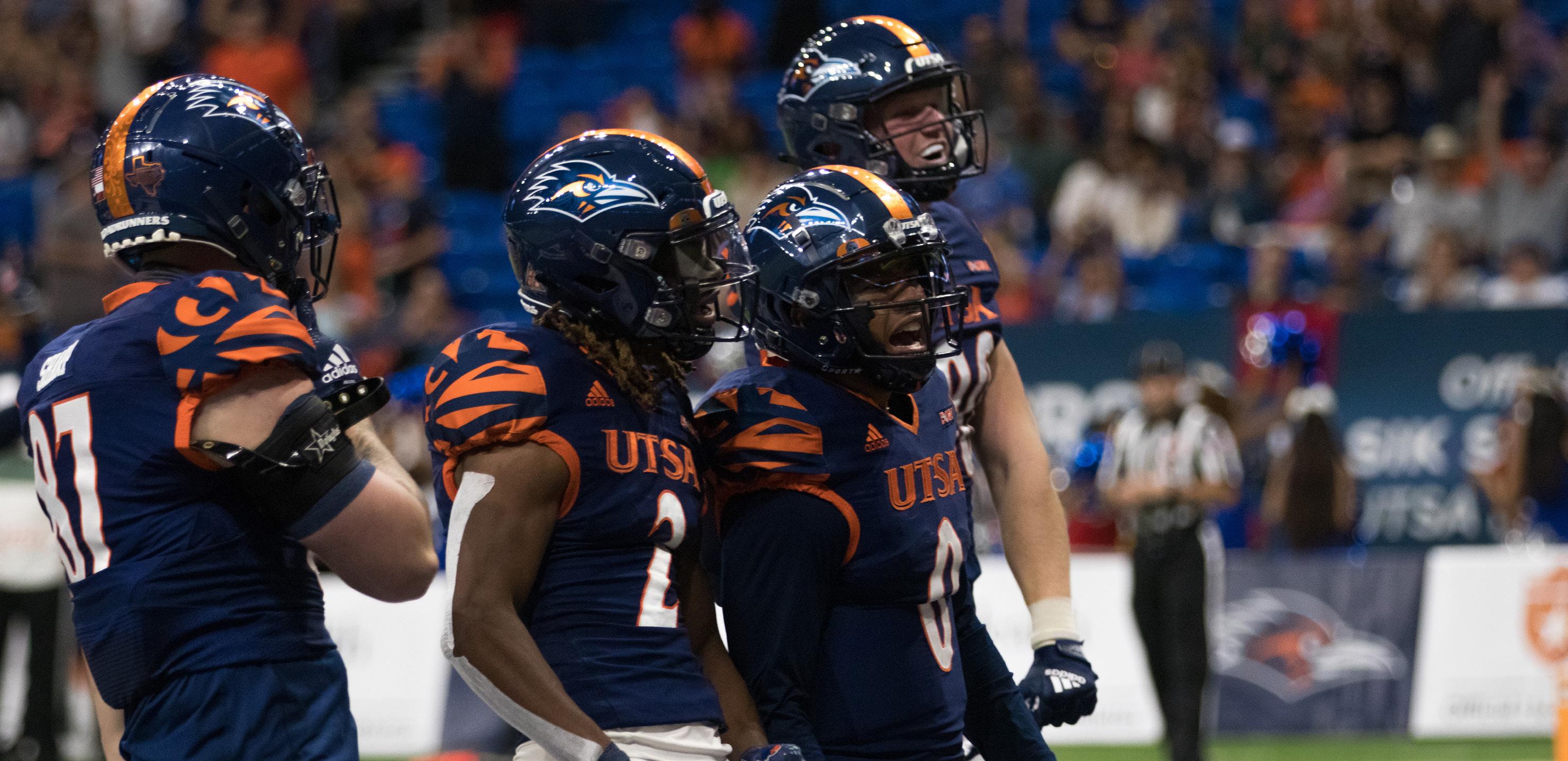
The Roadrunners’ more striking issues are on the defensive side. In C-USA, UTSA ranks seventh in total defense, while the University of AlabamaBirmingham (UAB) ranks number one.
UAB was picked to finish second in the conference in the preseason predictions, and so far is 2-1 in C-USA. In just about every defensive stat, the Roadrunners are in the middle of the conference, so UTSA will have to rely on their offense to outscore the opposition.
This is where UTSA’s veteran leaders and maturity will come in. The ‘Run ners are 7-1 in their last eight one-score games. UTSA has five more regular season games, and the second, third and fourth teams in C-USA’s standings are on UTSA’s schedule. These teams hap pen to be North Texas, Rice and UAB, and it can be assumed the ‘Runners will find themselves in a close ball game with one if not all of these teams. With the nationally dominant offense and middleof-the-pack defense, UTSA will likely find itself hosting another conference championship on Dec. 2.
UTSA volleyball (712, 2-5 C-USA) fell to the University of North Carolina at Charlotte and the University of North Texas at home last week. Both the 49ers (8-10, 2-4 C-USA) and the Mean Green (10-12, 4-3 C-USA) took the Roadrunners to a fifth set; however, it was too much to overcome for UTSA. The Roadrunners are 10th in the Conference USA standings.
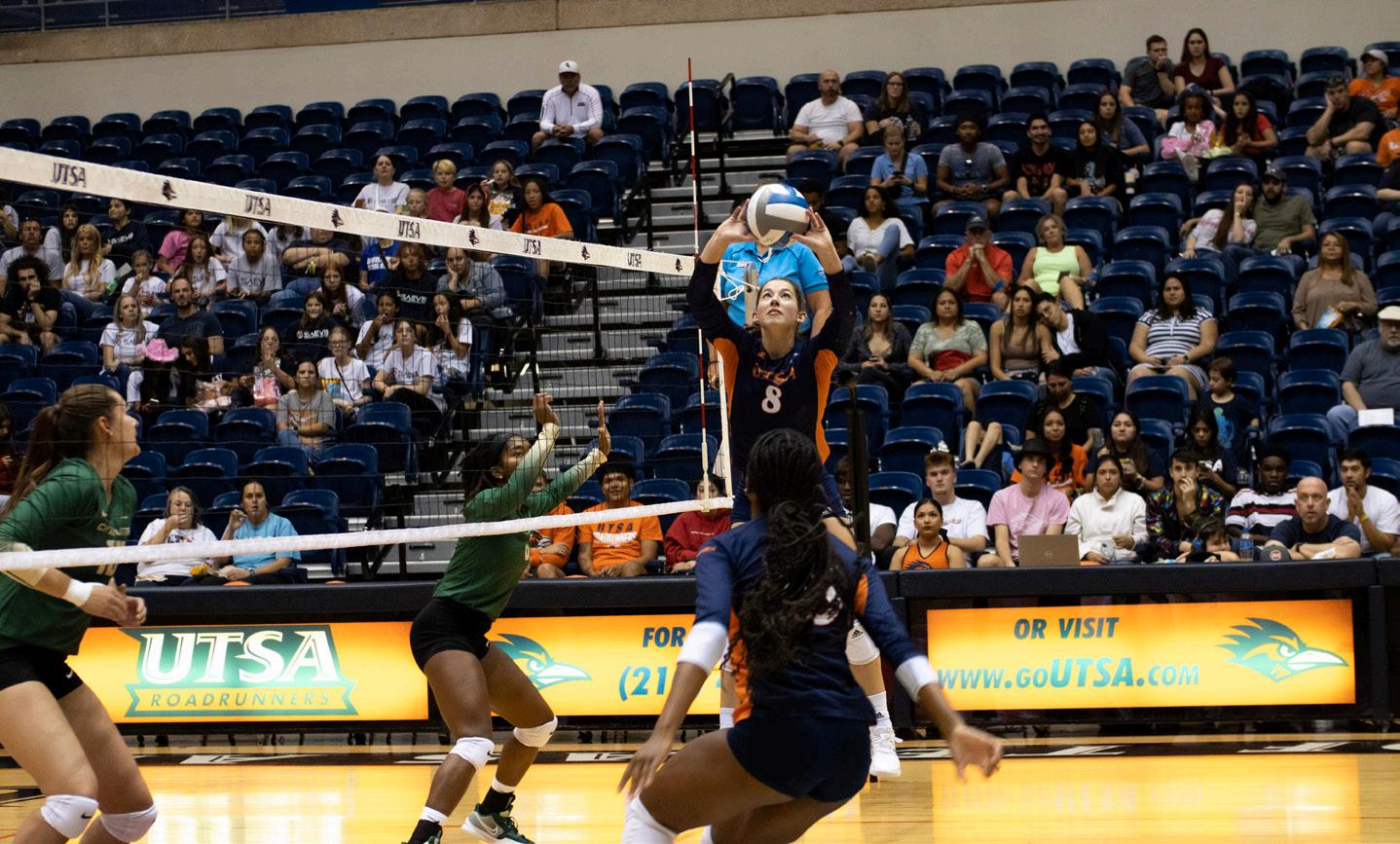
The first match for the ‘Runners came against Charlotte on Friday, Oct. 14. UTSA came out aggressive, winning the first set 25-20. The Roadrunners led by as many as seven points, and freshman Katelyn Krienke had a set-high of four kills. The second set was more of the same, with UTSA winning 2522. The match was close as the teams traded points until UTSA went on a 4-1 run to take a command
ing 19-15 lead which gave them the boost to win.
Unfortunately for the Roadrunners, the 49ers would win the next three sets. Emani Foster had eight kills in the third set for Charlotte, leading them to a 25-16 win to keep them alive. However, the 49ers exploded to a 16-8 lead in the fourth set and would go on to win 25-19, despite a comeback from the ‘Runners. In the final set, the teams looked as if it was going to be close as it was tied 3-3; however, Charlotte would take a lead and win 15-11, com pleting the 0-2 comeback.
Cansu Günaydin led the ‘Runners with 12 kills while Alicia Coppedge and Krienke had 10 kills each. Courtney Walters had 47 assists.
In a more back-andforth series, the ‘Runners lost another five-game series to North Texas on Sunday, Oct. 16. UTSA won a close first set 2523. Both teams were tied at 20 and the Roadrun ners closed on a 5-3 run.
Günaydin had three kills in the set. The beginning of the second set was the same as both teams traded points. The Mean Green closed on a 10-4 run which gave the game a lopsided feel as North Texas won 25-17. UTSA responded in the third set, battling out another close one losing 25-21. There were eight ties and three lead chang es; however, the ‘Runners were led by Krienke and Coppedge who each had four kills.
UTSA would answer in the fourth set. After an early lead, the ‘Runners went on to win 25-19 to force the fifth set. UTSA tied the game at 11 in the fifth set, even pushing the game to extra points. Still, the Mean Green won 17-15. Coppedge led the Roadrunners with 13 kills while Günaydin had 12. Mekaila Aupiu had 25 as sists while Walters had 21. The next time UTSA plays will be at 6 p.m. on Friday, Oct. 21, against UTEP (11-9, 5-2 C-USA).
There once was an era where a quar terback was hit and tackled like every other player on the field. Since the early 2000s, the rules have become easier for them. The main goal is to protect the quarterback as they make the most money. But now, football has strayed away from tackle and closer to two-hand touch.
The two main rules that protect a quarterback are targeting and rough ing. Targeting is described as when a player on either team lowers their head and makes helmet-to-helmet contact with another player during a football game. Roughing the passer is when a defensive player makes illegal contact with the quarterback after the ball is thrown. Ideally, these are perfect rules to

have to protect the defenseless quarter back against a six-foot-five, 300-pound defensive lineman. However, more and more of these calls are being made in crucial moments, many of which may directly influence the outcome of the game. In both col lege football and the National Football League (NFL), quarterbacks are protected at differ ent levels. In pivotal games like the 2019 Fiesta Bowl, Ohio State defensive back Shaun Wade hit Clemson Univer sity’s quarterback Trevor Lawrence above the neck. Wade was disquali fied for the remainder of the game, which heavily affected the result for Ohio State. In last Monday’s football game, the Kansas City Chiefs’ defen sive lineman Chris Jones strip-sacked the football from Las Vegas Raiders’ quarterback Derek Carr. However, after landing on top of Carr the call was re versed. The Raiders regained possession
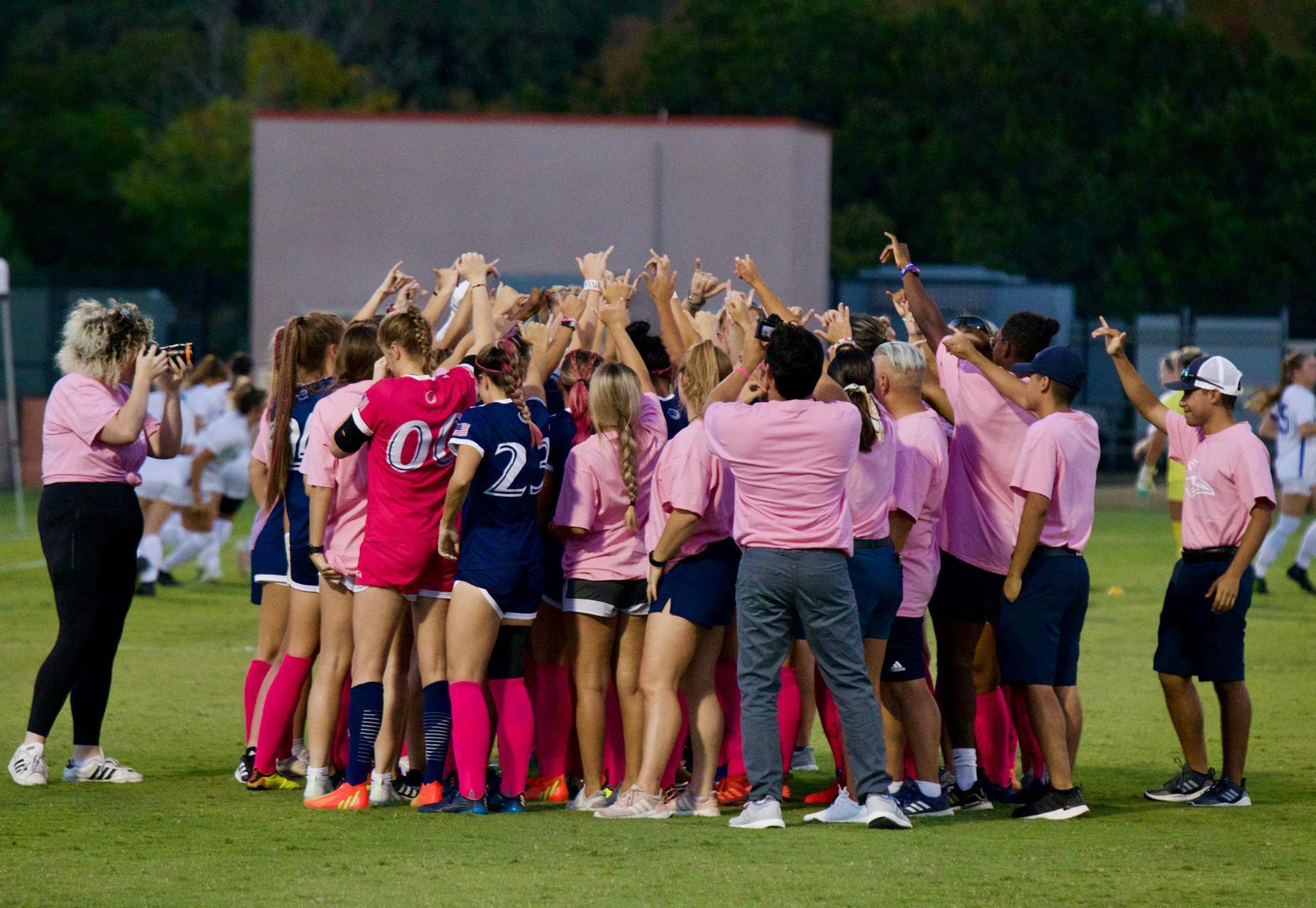 By Luke Lawhorn Sports Editor
By Luke Lawhorn Sports Editor
As the regular season is winding down, UTSA (7-54, 2-3-3 C-USA) played two critical games after not having won a game in several weeks. The Middle Tennessee State University Blue Raiders (2-9-3, 0-4-2 C-USA) were the first of two teams, while the Universi ty of North Texas Mean Green (9-5-2, 5-2-1 C-USA) were the second opponent.
In their first home game after the five-match road trip, UTSA showed their offensive dominance against Middle Tennessee, winning 4-0 on Thursday, Oct. 13. UTSA scored their first goal in the 14th minute after Deja Sando val launched a pass to Anna Sutter, who then passed the ball to Avery Chaney who bunted the ball into the net. The ‘Run ners scored again in the 21st minute when Sutter shot on the goal and was deflected by the Blue Raiders keeper; however, Alissa Stewart snuck past and scored the goal. Chaney got her second goal of the night in the 25th minute, putting the ‘Run ners up 3-0.
After outshooting the Blue Raiders eight to one in the first period, the ‘Runners main
tained that level of ascen dancy in the second period, outshooting Middle Tennes see five to one. Kiran Singh scored the fourth goal for UTSA in the 52nd minute and Sandoval had the assist. Though the Roadrunners did not score another goal, the defense held the Blue Raid ers to a victorious shutout, winning 4-0.
The Roadrunner’s next matchup was against North Texas on Sunday, Oct. 16. UTSA fell 3-1 but they still outshot the Mean Green 11 to 10. The first goal came in the fifth minute by Madi Starrett for North Texas.
Singh tied the game 1-1 in the 32nd minute off of a penalty kick. The Mean Green wasted no time re sponding with a goal by Kat Burnell in the 36th minute.
North Texas scored their final goal by Olivia Klein in the 61st minute. North Texas had six shots on goal while UTSA had four.
UTSA has two more regular season games before the Conference USA tourna ment. The next game for the ‘Runners will be at 1 p.m. on Sunday, Oct. 23.
By Cesar Soto Staff WriterWith the San Antonio Spurs com pleting their preseason, the squad can now look forward to the start of the regular season. After making many moves this offseason, the Spurs are looking to completely rebuild in a new and younger direction as they begin their 50th season as a National Basketball Association (NBA) fran chise.
After losing All-Star point guard Dejounte Murray in a trade to the At lanta Hawks and shooting guard Lon nie Walker to the Los Angeles Lakers, the Spurs now have new players looking to assume more significant responsibilities. More fresh faces are joining the team this year with three
of the ball and kicked a field goal. These controversial calls seem to happen once every game in both college and the NFL. This raises the question; are these calls ruining the game?
The quarter back position is the most valuable on the field. So, of course, it is best for the qual ity of the game if these players are protected like no other. In the NFL, owners often pay quarterbacks tens of millions of dol lars and will riot if their investment becomes injured.

Even in college, the quarterback is still the face of the team. But now, defenders are left with nothing else to do besides “wrap up” the quarterback. It is almost an instinctive moment for defenders to bow their heads an inch or so when caving in on a player; however, now that is an automatic flag from the refs and more than likely a disqualifica tion. Instead of the big-time hits, the
defender now has to drag the quarter back to the ground and still be at risk of getting a roughing the passer call.
The calls also wipe away any momen tum the game has. Reviews of question able hits on the quarterback can slow the game down, and if the conclusion is to disqualify the player for the remainder of the game, the defense almost plays lifeless. Of course, the quarterback should not be laid out on the ground and should be called more strictly than a running back or wide receiver, but the direction both leagues are heading in is that quarterbacks will only be brought down by a touch or wrap-up instead of a legitimate tackle. Quarterbacks know the risk they are signing up for and under stand part of the game is for defenders to stop offensive weapons, which quarter backs are.
Quarterbacks continue to get the benefit of the doubt. If they are slow to get up, or the crowd makes too big of a gasp, it seems that a flag will be thrown, then a defender will be punished. Quar terback safety should be held to a high standard; however, more often than not, it is becoming impossible for defenders to tackle, ultimately making the game more favorable for the offense.
Following the first of two belowaverage meets, the UTSA women’s golf team traveled to Broken Arrow, Oklahoma, to participate in the Dale McNamara Invitational on Oct. 10 and11. The Roadrun ners concluded the first day of the invitational in sixth place and held on to that position to finish sixth in the 13-team field. UTSA finished ninth a year ago in the same com petition.
Camryn Carreon led the ‘Run ners by also finishing tied for sixth
place individually with a 1-overpar 217. Carreon finished just four shots behind individual medalist Miu Takahashi from the University of Nebraska. Morgan Ellison fin ished second for UTSA and tied for 10th overall. Ellison fell four spots on the final day, finishing with a score of 2-over 218 and a teamhigh eight birdies.
Daniela Abonce fell three shots behind Ellison to finish tied for 16th place overall with a 5-over 221. Lauren Rios was the fourth ‘Runner to complete the 54-holes; however, she competed as an individual. Rios finished tied for
59th place with an 18-over 234. Olivia Williams and Hunter Nugent finished one shot apart, with Wil liams tied for 67th overall (8081-76—237) and Nugent at 69th (78-78-82—238).
UTSA finished six shots ahead of seventh place with a score of 888 (303-292-293), two shots behind Conference USA rival North Texas at 886 (292-294-300). Tulsa took first place as a team with an 868 (292-286-290).
The Roadrunners will now play in the Marilynn Smith Sunflower Invitational in Lawrence, Kansas, on Oct. 17 and 18.
first-round draft picks, including Jer emy Sochan. The Baylor forward was selected ninth overall, making him the highest Spurs draft selection since Tim Duncan’s draft back in 1997.
The key players to watch this sea son are forwards Keldon Johnson and Devin Vassell. Following his breakout season last year, during which he averaged 17 points and six rebounds per game, Johnson signed a four-year, $80 million extension with the team. All eyes are now on him to see what he will do to develop as San Anto nio’s primary option. Vassell is an other young player looking to assert himself more in the Spurs’ offense this year. Averaging 12 points per game last year, he’s a 3-and-D player that will undoubtedly factor in how
well the team performs this season. Young point guards Tre Jones and Joshua Primo will play a prominent role in the team’s development during the regular season, while learning how to orchestrate the Spurs’ offense properly.
The Spurs are not expected to make much noise this season, likely fin ishing at the bottom of the league’s standings, but this is best for the team’s future. Next year’s draft class is expected to be headlined by Victor Wembanaya, one of the most highly sought-after prospects in recent his tory and a player the Spurs would surely love to build around. Head coach Gregg Popovich himself has said not to expect great play from the Spurs this year, and while it is rare to
hear a coach admit that, he is right. Used to coaching championshiplevel teams, Popovich is tasked with a different role this year. The goal for him and San Antonio this year is to focus on their young guys’ growth and give them opportunities to learn the game and improve. With the help of veterans like center Jakob Poeltl and forward Doug McDermott, the Spurs will be able to determine how and with whom they move forward in their new direction. Even though they probably will not be the best team on the court in most games, Spurs fans should find plenty of interest in watching these young talents blos som.